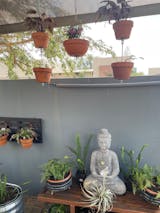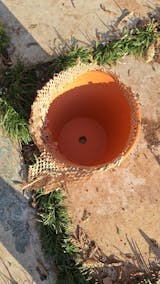
The Haemanthus Gardening Guide
Imagine driving up the breathtaking Sani Pass in South Africa, where Haemanthus reveals her splendour, blooming wild atop the rugged mountain terrain. As you ascend to higher altitudes, you will encounter this remarkable indigenous flower nestled against rocks in Mpumalanga, the Free State, and the Drakensberg. While most Haemanthus species are deciduous, three—H. albiflos, H. deformis, and H. pauciflorus—stand out as evergreen varieties. These plants boast large bulbs wrapped in fleshy tunics and develop impressively long, thick roots.
Haemanthus thrives not only in these high-altitude regions but also in semi-arid areas, including Namibia, Lesotho, and Swaziland. Across these diverse habitats, there are 22 distinct species of Haemanthus. Similar to the Amaryllis belladonna (commonly known as the naked lady), which belongs to the same Amaryllidaceae family, Haemanthus species from winter rainfall areas showcase their flowers before their foliage appears. This behaviour has earned H. coccineus, in particular, the nickname “April Fool.”
In contrast, those from summer rainfall regions produce flowers and foliage simultaneously. Haemanthus untamed beauty can also be harnessed for your garden, flourishing in both sunny and shady spots. Following their stunning blooms, these plants produce vibrant red berries, a favourite treat for birds. Ideal for container gardening and remarkably easy to cultivate, Haemanthus paints any landscape with wild magic.

Here’s The Haemanthus Gardening Guide to get you on your way to cultivating this local lovely with ease and transforming your garden into a haven of natural beauty.
What is the common name for Haemanthus?
Common names for Haemanthus include paint brush, and powder puff.
Is Haemanthus poisonous?
Handle Haemanthus bulbs with care—think of them as the divas of the plant world: beautiful, but a little dangerous. These toxic bulbs are not for snacking, so keep them well out of reach of curious children and pets. Trust us, your furry friend’s adventurous taste buds don’t need this kind of excitement!
How do you care for a Haemanthus plant?
Cultivating Haemanthus with ease is as simple as this: grab some bulbs and pick the perfect spot for them to call home. They will happily settle into a rockery or make a bold statement in a container. While a single Haemanthus in a pot looks lovely, why stop there? Embrace the rule of three for a truly show-stopping display and space each bulb about 20cm apart! Group plantings of three in a semi-shaded spot, like under a tree, will add a touch of magic to your space.
Make sure the soil is light, friable, and enriched with compost. If planting in the garden, loosen the soil to a depth of about 40cm, and consider adding sand to improve drainage. When placing the bulb, nestle it into the ground with its neck just peeking above the soil. These hardy beauties are low-maintenance: water them generously during spring and summer, but give them a break when they go dormant—keep the plants mostly dry. For container-grown Haemanthus, let them do their thing undisturbed for several years (around five years works best).
If your plants seem stressed—think yellowing leaves or seriously sluggish growth—it’s little beyond time to lift and separate the bulbs for a fresh start.
Haemanthus bulbs are flexible, ready to be planted any time of year, and they will reward you with blooms from early to late summer. Reaching a mature height of 20–30cm, they’re frost-tender, so keep them away from icy conditions unless you want them to disappear faster than biscuits at tea time!

What is Haemanthus used for?
Haemanthus isn’t just a pretty face—she’s had a side gig in traditional medicine. The uses being to treat ulcers and asthma. Talk about functional beauty! Just remember, medicinal use is best left to the experts—don’t go brewing bulb tea at home. Their toxicity is why moles and mole rats leave them alone.
More about Haemanthus
The name Haemanthus is derived from the Greek haema meaning blood and anthos meaning flower. These bulbs were one of the first Cape bulbs to be sent to Europe by Dutch traders over 400 years ago, and when they bloom, they delight in shades of pink, red and white.
From around 1970, species that were once in this genus that have leaves on the stem are now classified under the genus Scadoxus. 15 Haemanthusspecies are from winter rainfall regions and 6 are from summer rainfall regions, with exception of H. albiflos which is to be found in both. Alarmingly though, 12 species are on South Africa’s Red Data List. Only purchase bulbs from recognised retailers and not from sources that have potentially harvested bulbs from the wild.
The most rewarding Haemanthus species for cultivating in your garden are H. carneus, H. crispus, H. sanguineus, H. humilis, H. montanus, and H.albiflos.Take your pick and paint the garden with Haemanthus.
Happy planting!


September
20 - 21,
2025





Leave a comment